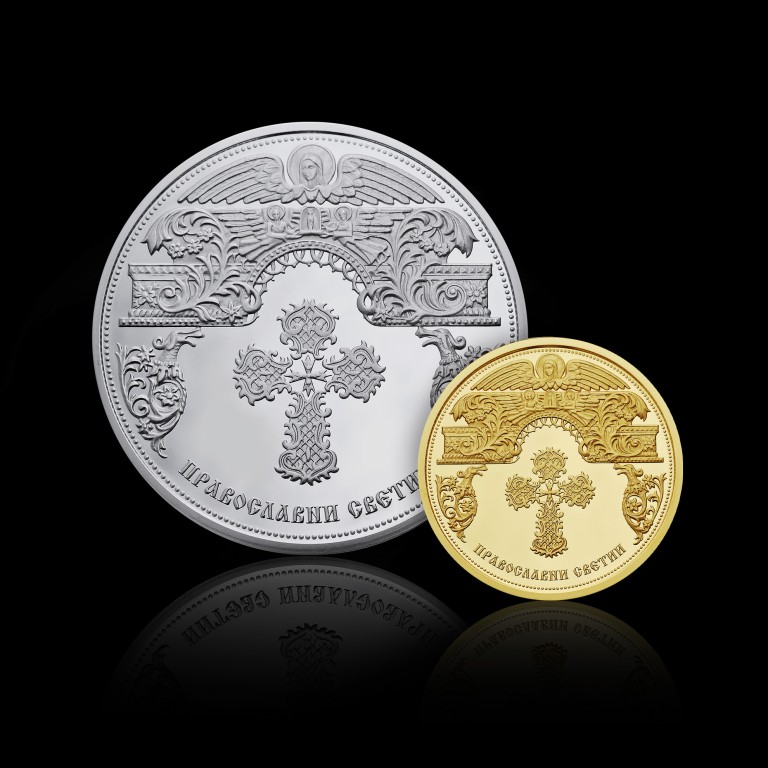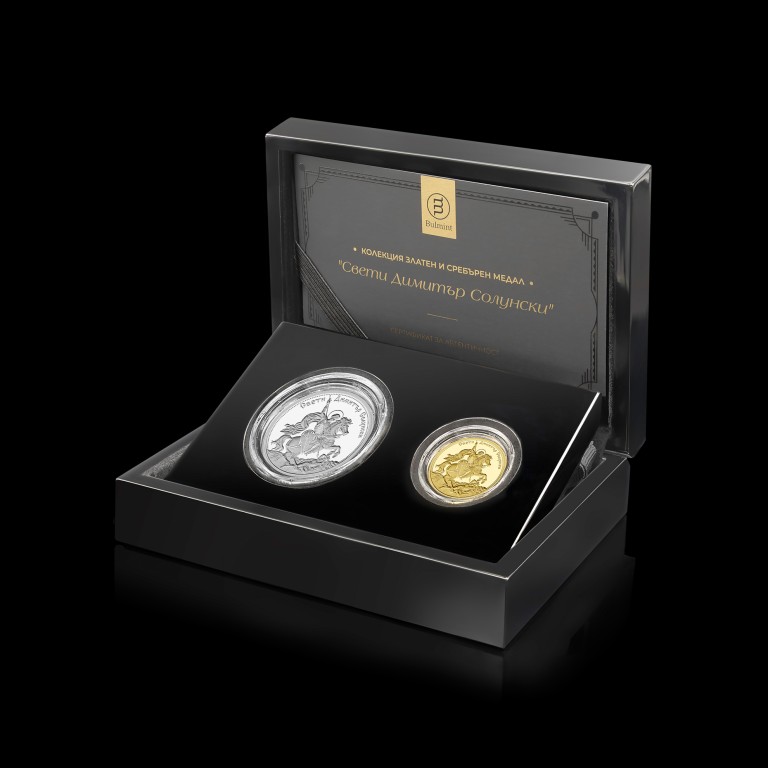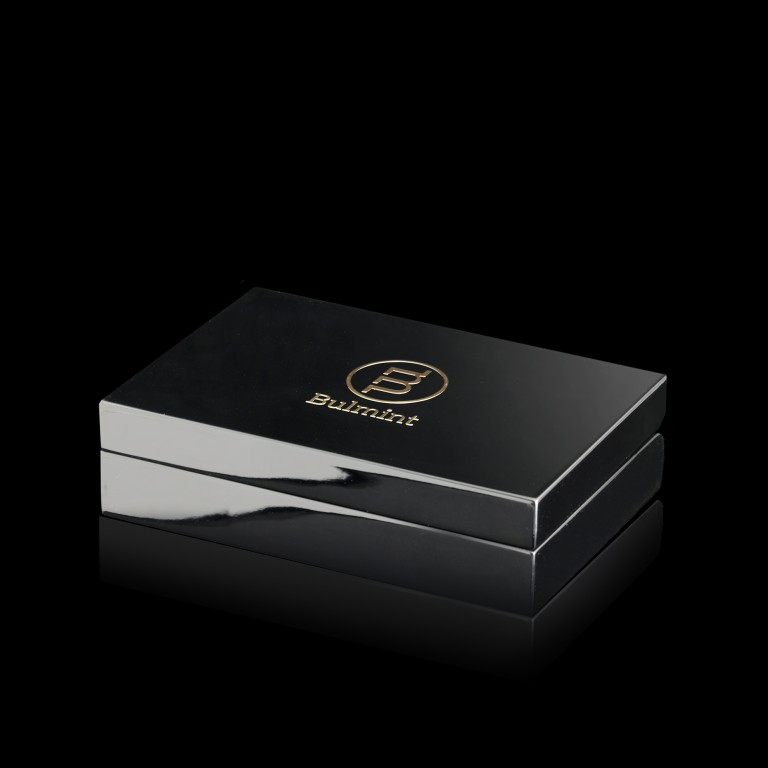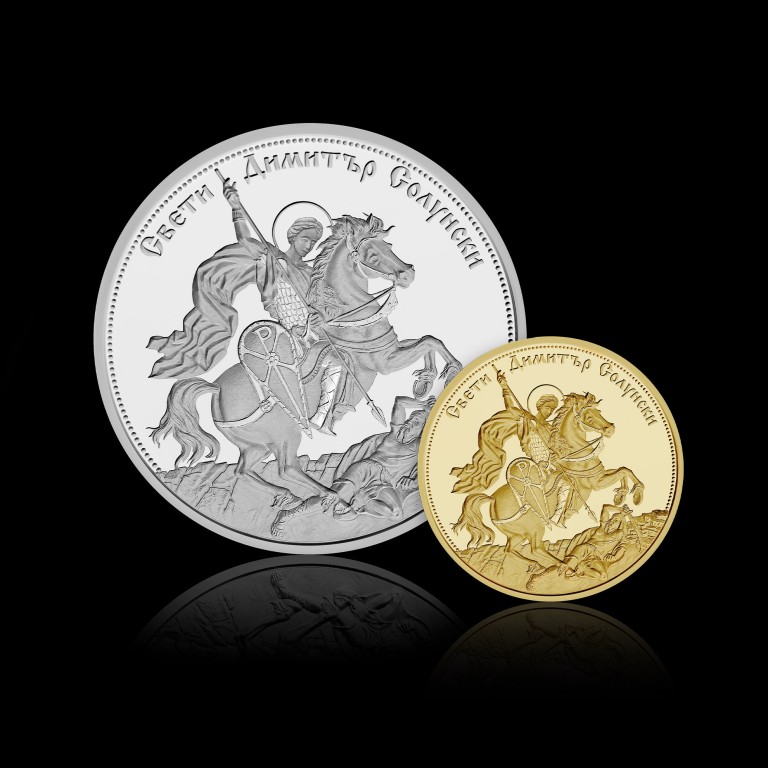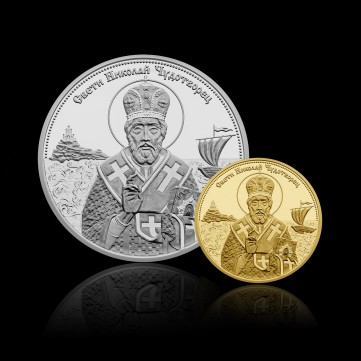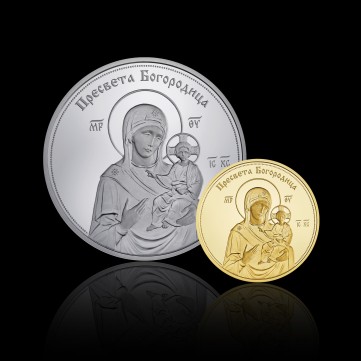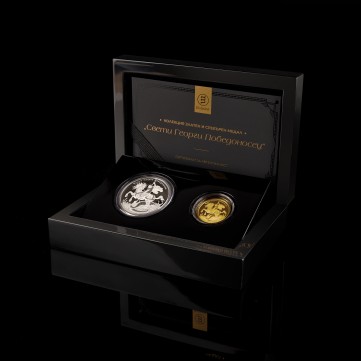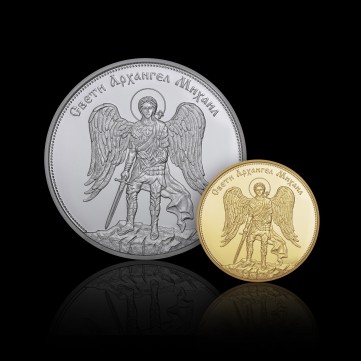Saint Demetrius of Thessaloniki Gold and Silver Medal Collection
2921.00 BGN / 1493,48 €A 7.78-gram 999.9 fine gold medal and a 31.1-gram 999.9 fine silver medal, packaged in a luxury box – a gorgeous and original gift for Saint Demetrius’s Day or another special occasion. The shared obverse motif is inspired by Orthodox icons of the holy man.
The revered image of Saint Demetrius of Thessaloniki joins the Orthodox Saints Medal Program – the patron of the Second Bulgarian Empire’s capital city, Veliko Tarnovo.
Saint Demetrius ranks among Christianity’s so-called “military saints” and enjoys particularly high esteem among Slavic peoples. Churches in his honour are still being built to this day, and approximately 170,000 Bulgarians celebrate their name day on his feast day, October 26.
This collection consists of two medals sharing the same motif inspired by the traditional iconography of Saint Demetrius of Thessaloniki. They are struck to proof matt-gloss quality with an exceptionally high level of detail. The gold medal is made of 7.78 grams of 999.9 fine gold with a diameter of 24 mm, while the silver one is made of 31.1 grams of 999.9 fine silver with a diameter of 38.6 mm.
On the obverse of each medal stands the most common type of depiction of Saint Demetrius – as a cavalryman clad in armour, slaying the “King of Infidels” or antichrist in the guise of an enemy soldier. His shield is decorated with the Chi Rho – a symbol of Jesus since the 2nd century AD, later popularised by Emperor Constantine the Great. Select details from the saint’s armour, as well as embellishments on his horse’s reins, gleam with captivating beauty thanks to their satin finish.
The highly ornamented iconostasis of the Nativity of the Blessed Virgin Mary Church in Rila Monastery adorns the reverse of all medals in the Orthodox Saints Program. The iconostasis was made between 1839 and 1844 and is the work of Atanas Teladur, famous Revival Period woodcarver and founder of the woodcarving movement of the Samokov Art School. Here it frames an Eastern Orthodox cross faithful to the iconostasis’ style.
You get the two medals in a luxury black wooden box decorated with a metallic logo. The medals are on a raisable platform that transforms this accessory from a place for storage to a stunning display option.
You can also buy the silver and the gold medal from the Saint Demetrius collection separately, each in its own luxury box.
Metal
Fine Gold and Fine Silver
Purity
999.9/1000
Edging
Smooth
Quality
Proof
About Saint Demetrius of Thessaloniki
The Great Martyr Demetrios of Thessaloniki is also known as Myrrh-gusher.
He was born and lived in the Greek city of Thessaloniki, then part of the Roman empire – the son of the city’s consul, who secretly practiced the Christian faith. The young Demetrius himself converted to Chrisianity when he was of the right age. After his parents’ death he inherited a sizeable fortune, and Emperor Maximian Herculius eventually gave him his late father’s position – along with orders to cleanse the city of all Christians. Not only did Demetrius not carry out his orders, but he went directly against them and began to protect the Christian population of Thessaloniki and spread the faith. His work was successful for a time, until the next emperor, Galerius, learned of his betrayal and imprisoned the holy man.
A number of miracles are attributed to Saint Demetrius during his time in the Roman holding cells, as well as to his relics after his death.
Legend has it that through the power of prayer he helped the Christian man Nestor defeat the fearsome Lyaeus in battle – a warrior who brought death upon countless followers of the Christian faith in duels organised for the emperor’s entertainment. Nestor won, but was executed in return – and, after him, the imperial soldiers directed their vengeance at the the man who aided him.
After Saint Demetrius’s death, his servant Lupus took his clothing and ring, still crimson from the holy man’s blood, and continued his legacy until his own martyr’s death. Years later, when Saint Demetrius’ relics were rediscovered, a temple was built to house them. When they were being transported, myrrh began to stream from them – that is how the saint gained the appellation Myrrh-streamer.
Feast and veneration
The Orthodox Church honours this saint of Saint Demetrius’s Day on October 26.
Despite not being a soldier in life, his traditional iconography portrays him as one of the “military saints”, usually shown on horseback. Much like Saint George, he is depicted slaying a symbol of evil – a fallen enemy soldier who represents the “king of infidels” or the Antichrist.
In Bulgarian culture the year is divided into summer and winter, and Saint George is the herald of the warmer months, while Saint Demetrius is the herald of the colder months. The Saturday before Saint Demetrius’s Day is a Saturday of Souls. The holy man’s feast is tied to the end of the shepherd’s season and the preparation for the oncoming chill. Popular folk practices on the feast day itself and the one directly following it include fortune telling rituals for the upcoming year.
We dedicated this program to the saints thousands of Christians turn to with prayers of good health and protection, aid and spiritual guidance. It will consist of 12 medal collections dedicated to 12 holy men and women central to Eastern Orthodox Christianity. Each motif will be struck to proof matt-gloss quality onto two medals made of the finest gold and silver.
The number 12 itself is steeped in symbolic meaning - it bears significance in every corner of the world and in more than one religion or culture. That is how many months there are in a year according to most calendars. Its significance is especially pronounced in the Christian Bible. There are twelve holy apostles in the New Testament - chosen confidants and students of Jesus Christ, who were the ones to spread his gospel. The days between the Nativity of Christ and Epiphany are also twelve. Eastern Orthodox Christianity observes twelve Great Feasts - each dedicated to a pivotal moment in the life of Jesus Christ or the Virgin Mary, second in significance only to Easter.
The reverse design shared by the medals in this collection draws inspiration from the gilded iconostasis from the Nativity of the Blessed Virgin Mary Church in Rila Monastery - a composition of richly ornamented woodcarvings depicting floral ornaments, stylised animals and angels. This iconostasis was made between 1839 and 1844 by the master woodcarver Atanas Teladur, founder of the woodcarving movement of the Samokov Art School.
The iconostasis holds a place of high importance in interior church architecture - it represents the divide between Heaven and Earth. It acts as a partition between the altar, to which only members of the clergy have access, and the congregation. It is also the frame upon which the majority of the church icons are hung. The Orthodox churches of Bulgaria, particularly the ones from the National Revival Period, are known for their intricate handcarved wooden iconstases, each steeped in Christian symbolism and local folk motifs.
We ship our orders with Econt Express. The cost of delivery is at the customer's expense and includes insurance, cash on the delivery fee, if applicable, and courier service. The total delivery cost is formed based on the chosen method of payment and the method of delivery.
Orders received by 3 p.m. on working days and chosen payment method cash on delivery or credit card are processed and shipped on the same day. Orders received after 3 p.m. or during the weekend, are processed and dispatched on the next working day.
Each shipment has the "Check" option. In case the customer decides to return the order, the delivery and return costs are at the expense of the customer.
Product is out of stock
Enter your e-mail address and we will notify you when the product is back in stock.

